
Back in November, the FanGraphs staff ranked Marcell Ozuna as the seventh best available free agent. In that article, Kiley McDaniel and the FanGraphs crowd both expected Ozuna would receive a four year deal, with the median crowdsource estimate coming in at $64 million ($16MM per year) while McDaniel was a little higher at $70 million ($17.5MM per year). Teams could dream on Ozuna’s potential and a return to his 2017 production with relatively minimal risk – since his 2013 debut, Ozuna has consistently produced as an average or better player. Coming into this offseason, he had produced more than 2 WAR in four straight seasons dating back to 2016. Free agents are never a sure bet, but Ozuna seems pretty close to one at a reasonable price.
Flash forward to today, and Marcell Ozuna remains unsigned. This might not have been surprising in last year's slow market, but the 2019-2020 market has moved more quickly. The only player ranked ahead of Ozuna in the FanGraphs rankings who hasn’t signed a contract is Josh Donaldson, and you have to go down to #11 to find the next unsigned player (Nick Castellanos). Ozuna and Castellanos have similarities, and the way you rate them against each other likely depends on how you view each of their defensive abilities (or lack thereof). In any case, whatever team ends up signing Ozuna will probably be the one who puts the most stock in his ceiling.
With that context, I wanted to see what happened during his breakout 2017 campaign and what might be holding him back from tapping back into that potential. We’ll start with some numbers:

Many breakouts start with improvements in approach, and Ozuna’s was no different. His non-contact wOBA (driven by strikeouts, walks, and HBP) jumped from .155 in 2015 to .195 in 2016, or, in other words, from pretty bad to pretty average (MLB average is around .200). He maintained those gains in 2017 and 2018 before making another jump into pretty-good territory in 2019. Ozuna’s ability to maintain his non-contact gains is a good sign if we want to believe he can re-unlock his 2017 form, and so far he looks like he has that part of his game covered.
Now the fun stuff. The next four lines are different ways I like to measure contact quality. We know Ozuna hits the ball hard, with an average exit velocity ranking in or near the top ten percent of hitters each year since in 2015 when that data became publicly available. His average exit velocity of 91.8 mph in 2019 is tied for his highest over that period.
Ozuna’s 2017 breakout was marked by an improvement in his ability to generate the best contact more often, as evidenced by a jump in his barrel rates as a percentage of batted balls and plate appearances. Again, he’s maintained the gains made in 2017 and even continued to improve in 2019. His expected slugging percentage (used here to measure overall contact quality) made a similar jump in 2017 and, while it’s varied some, improvements over the younger version of Ozuna are still there. And, once again, 2019 was Ozuna’s best season according to this metric.
Obviously, those numbers don’t tell the whole story. Those metrics all show a player who broke out and continued to perform at a high level. If you’re reading this blog, you probably know the Cardinals didn’t get the 2017 version of Marcell Ozuna after they acquired him from the Marlins. Here’s his actual wRC+, along with an estimate of his expected wRC+ (derived from xwOBA) based on exit velocities and launch angles:

The expected numbers back up Ozuna’s breakout from 2015 to 2017 – the plate discipline gains along with contract quality improvements culminated in a great hitter. Ozuna has regressed some since then, but he continued to look like a high level performer in 2018 and 2019, if we were only looking at the expected numbers. Based on the actual results, however, 2017 stands alone as an outlier. The gap between his expected wRC+ and actual wRC+ was 15 points in both 2018 and 2019 and would make him one of the "unluckiest" hitters in baseball. What gives?
For all the great things we can garner from Baseball Savant, their expected metrics leave out a few critical components. Two of those components are batted ball spin (more on this later), and – most importantly – spray angle. A 390-foot fly ball to left field is a home run almost every time; a 390-foot fly ball to center field is an out almost every time. With that in mind, look at where Ozuna’s fly balls have clustered over the last few years.
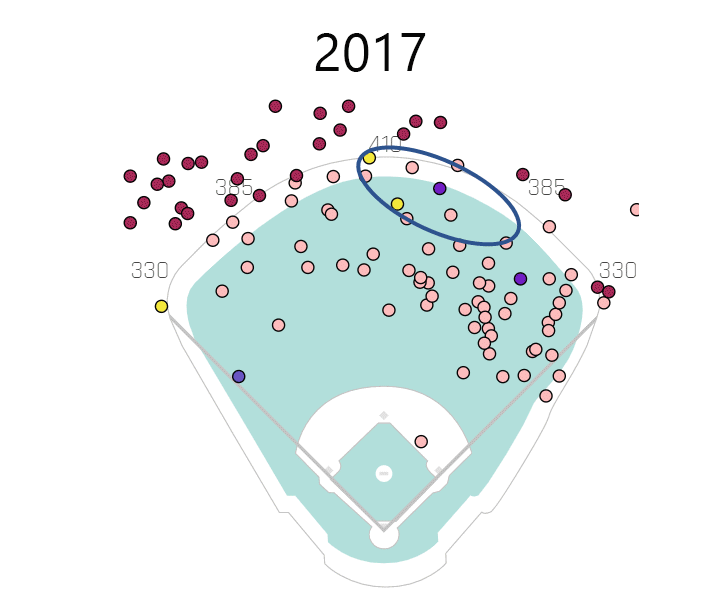
There’s a cluster in shallow right field. Those are mis-hits, and most mis-hit fly balls are popouts to the opposite field. That cluster is normal. There’s another cluster, however, in the 2018-2019 chart, and it’s a cluster of outs near the center / right-center warning track. Those aren’t mis-hits. Those are drives that are falling just short. The expected slugging percentage on those outs is over 1.400 – something like 60% of balls hit at that velocity and launch angle are doubles or home runs. For Ozuna, those have mostly turned into outs, in part because he’s hitting them to the wrong part of the field.
There’s a little more to it, though. On average, Ozuna hit these fly balls approximately 100 miles per hour at an average launch angle of 33.5 degrees, and their average flight was 365 feet. When the rest of the league hit the ball at similar angles at similar velocities in a similar direction in 2018, they went 373 feet. In 2019, they went 379 feet. Ozuna’s fly balls to this part of the field are traveling about ten feet less than we would expect them to fly, and the lost distance has turned a number of potential home runs into outs.
Thanks to the great @cardinalsgifs, we can watch a few of these outs and see where he’s losing distance. Here’s a warning track drive from 2019 against Oakland:

Warning track power here, and neither broadcast sounded terribly convinced that the ball was going to leave the yard. Still, similar balls went for home runs or extra bases about a quarter of the time in 2019 and traveled an average distance of 398 feet – Ozuna’s fell in a glove 389 feet away. Nine more feet, and the ball is probably in the stands.
As I mentioned above, another input missing from the Statcast model is batted ball spin. Typically, when we talk about batted ball spin, we’re talking about backspin and whether it provides extra carry. For Ozuna, the issue appears to be a result of side spin. Think about how a golf ball flies off a driver – a straight drive, where the spin (backspin) is aligned with the direction of the ball’s flight, travels further than a sliced drive, where the spin is perpendicular (sidespin) to the ball’s flight. We can’t say for certain whether Ozuna's flyout had sidespin, because that data isn’t available (to my knowledge, at least). But we can look at the balls flight path:

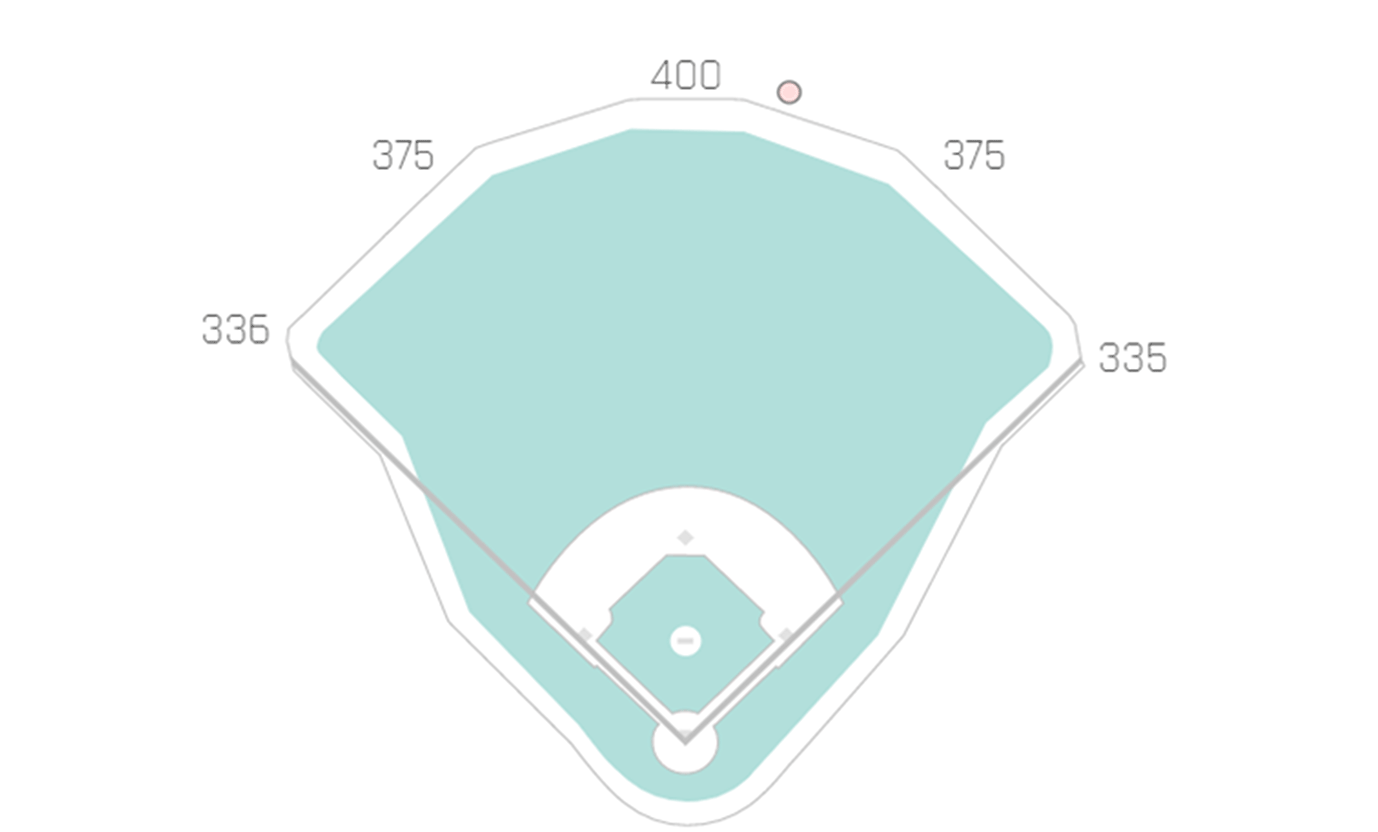
(Excuse the dot. Baseball Savant estimates where the ball would land if not caught, and that's where this dot was placed. you saw it was short of the fence).
The ball starts out traveling (just) barely to the left side of the second base bag. It ends about ten feet right of Freese’s lawn. I’m not a physicist, but that ball probably had a lot of side spin. If it didn’t, it would have flow straighter and had a better chance of reaching the bleachers (or lawn).
Compare that flight to this blast from 2017:
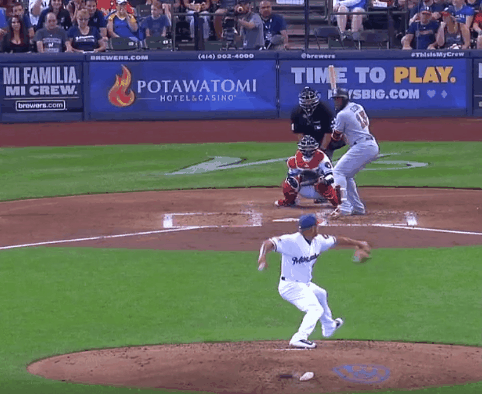
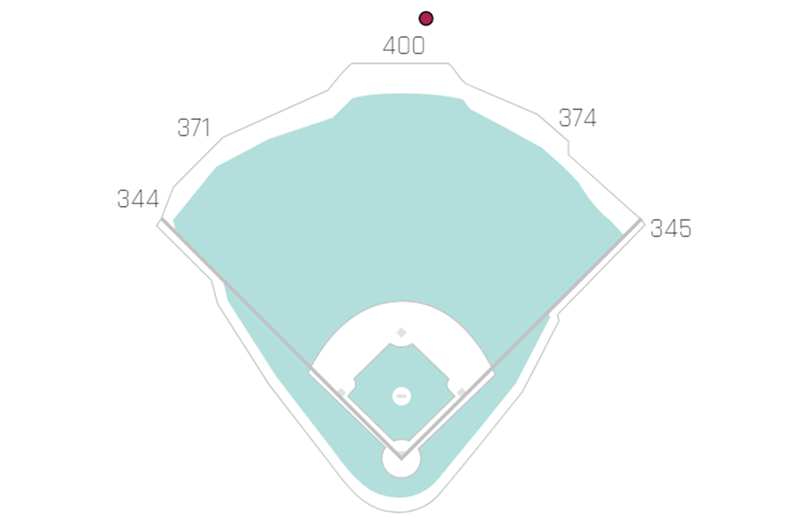
There’s still some slice there, but to my amateur eye it appears that there’s considerably less. This ball was hit a little harder at 104 mph, and a little lower. For the shape of the flight, that matters. To me, though, it seems like there’s a lot more pushing this ball forward than there is pushing it sideways.
Sliced fly balls aren’t necessarily a symptom of anything bad for a hitter. Balls hit to opposite field will slice, balls hit to the pull side tend to hook, and balls hit toward center might do either. It depends on the hitter’s swing, and where in the swing path a hitter makes contact.
Here’s a fly ball that Ozuna hit toward left-center, which you’d typically expect to stay relatively straight or maybe even hook slightly:

The camera pans out after contact, and the cameraman is looking for a ball toward left-center. Which makes sense, because the ball start flying over the shortstop’s head. The ball, which started near the shortstop, ended up in center field:

Now, we’re talking about one fly ball here. Maybe this wasn’t Ozuna’s best swing. Maybe Busch Stadium had all the air conditioning blow from the left side of the field toward the right. But balls hit like this one normally travel 416 feet, and balls hit like this one that start toward left-center usually end up in the stands. Danny Mac thought this was in the stands. But this ball didn’t even travel 400 feet. It was short of the wall because its flight looked something like this:
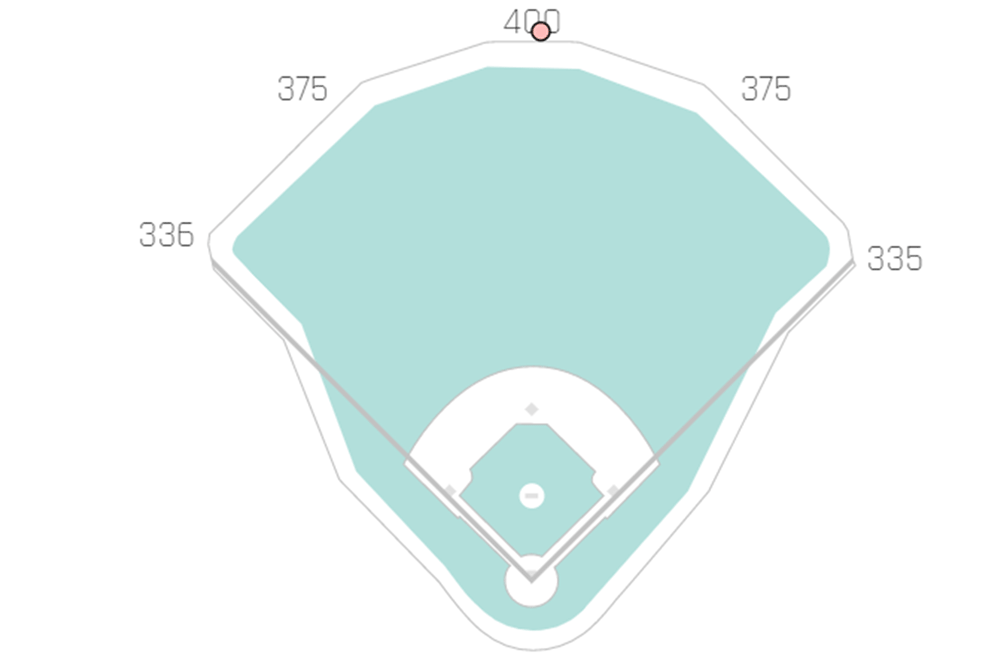
That ball is sliced. It’s hard to pull a fly ball toward left field and then banana curl it over to center without a swing that’s geared up to smash the ball into the left field foul pole.
Over the last few years, there’s been a lot written about the benefit hitters can realize by pulling more of their fly balls. A pulled fly ball has been called the ideal result of an at-bat. Ozuna broke out in 2017, at least in part, because he made the most of his pulled fly balls. In 2019, it looked like he was making more of an effort to pull the ball - his pulled fly ball rate of 33.6% was significantly higher than the 25% rate he ran in the previous three years.
I’m speculating, and I admittedly haven’t spent the time to watch enough of his at-bats to make a convincing conclusion. It looks like the potential mechanical issues I noticed in 2018 were fixed in 2019. However, based on what I watched this time, it looks like Ozuna’s step during the 2019 season was sometimes more toward the third base side than it was in the 2017 season. It also looks, to me, like his upper body was sometimes flying out in an effort to hit the ball to left field. That’s not necessarily a bad thing, but there are trade-offs to every adjustment. The benefits have to outweigh the costs.
Statcast’s metrics love Marcell Ozuna, and I hope he finds a team willing to bet on him with a life-changing contact. Still, the ball flight that a hitter generates is a skill. Marcell Ozuna might not be great at that skill, and it might limit the damage he can do at the plate. Somewhere, there’s a key to unlock Marcell Ozuna’s lofty ceiling. Some team’s hitting coach should be taking a good, hard look.
Credit to Baseball Savant’s Statcast Search for most of this data and their video library, and to FanGraphs for various stats used throughout. Big thank you to @cardinalsgifs for his incredible work, again. I made some estimates here on the ball flights, because flight data isn’t available. Those estimates were made in good faith, but they won't be completely accurate.

